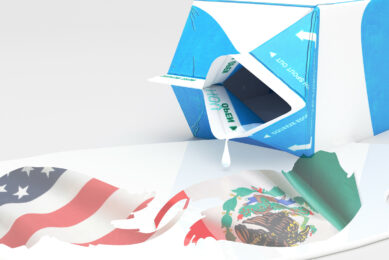US dairy market thriving but innovations needed

The dairy aisle, commanding an impressive US$76 billion in annual sales in the US, stands as the largest category in retail, showing remarkable growth, according to a new CoBank report. However, evolving consumer tastes and purchasing patterns necessitate continuous innovation from dairy processors, manufacturers, and marketers to keep pace with changing preferences.
Based on the latest 52-week rolling average Circana sales data through June 2024, the dairy aisle’s US$76 billion in annual sales reaffirms its position as the largest retail category. Over the past 3 years, dairy retail sales have surged by 15.4%, adding US$10.1 billion to the category. This growth rate surpasses that of liquor, which holds the second position in retail sales.
Interestingly, this growth isn’t solely driven by recent price inflation. Per capita dairy product consumption has increased by 7.7% over the past decade, translating to a compound annual growth rate (CAGR) of 0.8%, with consumption rising from 606 (275 kg) to 653 pounds (296 kg) per person on a milk-fat equivalent basis, according to USDA data. It’s important to note that this data reflects domestic consumption and does not include US dairy exports, which accounted for over 22% of the US milk supply in 2023, based on skim-solids.
Despite this overall increase, not every dairy product category has fared well, the report says. Fluid milk, for instance, has seen a decline, with a negative CAGR of 2.3% over the past decade. In contrast, butter, cheese, and yogurt have significantly compensated for the drop in fluid milk consumption.
Dairy alternatives have stalled
Over the past 25 years, per capita consumption of these key dairy products has seen substantial increases: butter up by 43.2%, cheese up by 45.8%, and yogurt up by a staggering 142%, according to USDA data.
Between 2021 and 2024, dollar sales data reveal that butter and butter blends grew by 26.4%, natural and process cheese increased by 9.8%. Yogurt saw a rise of 28.2%, as reported by Circana’s 52-week sales data ending 2 June 2024.
Despite the growing media attention on plant-based dairy alternatives, these products have stalled in recent years, CoBank emphasises. Real dairy cow’s milk continues to dominate, with dollar sales 21 times greater than those of plant-based dairy alternatives. And traditional dairy is expanding its market share across all categories.
Cheese remains a cornerstone of the US dairy market. Per capita cheese consumption continues to climb, with Americans eating about 40 pounds (18 kg) per person by 2022, up from just 10 pounds (4.5 kg) in 1967. The growth trend is evident in American-style cheeses like cheddar, which has experienced a 2% CAGR, and the larger category of non-American cheeses, primarily mozzarella, which has posted a 1.6% CAGR.
Strong growth in yoghurt and cheese snack market
Cheese consumption in the US shows more room for growth when compared to European trends. For instance, French and Danish consumers eat over 60 pounds (27 kg) of cheese annually, and residents of Austria, Finland, Germany, Greece, the Netherlands, and Switzerland all consume more than 50 pounds (23 kg) per year, according to the International Dairy Federation.
While USDA’s Dietary Guidelines for Americans hasn’t completely factored in new scientific research debunking the linkage between saturated fats and cardiovascular disease, CoBank says consumers have been taking note. Butter’s compound annual growth rate of 0.9% has pushed it past 6 pounds (2.7 kg) per capita, according to USDA data. However, butter still needs to grow to reach its pre-World War II peak of nearly 17 pounds (7.7 kg) per capita.
Yoghurt has evolved beyond a breakfast staple to become a versatile food product, with per capita consumption increasing by 142% over the past 25 years. Innovations like Greek yoghurt and new formats, such as yoghurt drinks and snack cups with mixed-in treats, have contributed to this growth. Recent FDA announcements allowing qualified health claims regarding yoghurt’s potential to reduce the risk of type 2 diabetes could further boost its popularity. Additionally, the rise in weight-loss drug use has positively impacted yoghurt sales.
With an estimated 90% of Americans snacking between 1 and 3 times per day, marketers are positioning cheese as an ideal component of a regular snacking diet. The global cheese snack market is projected to reach US$75.1 billion this year, with North America accounting for 23.9% of this total. This market segment is expected to grow at a CAGR of 6.5% through 2034, driven by new flavours, formats, and formulations.
Consumers have no plans to cut back
The lactose-free dairy product segment presents an important innovation opportunity for dairy processors. It caters to the approximately 120 million Americans who are unable to tolerate traditional dairy products due to lactose intolerance. The challenge is significant, as 1 in 3 Americans experiences lactose sensitivity or intolerance, with the highest rates among people of Eastern Asian, indigenous American, African, and Hispanic descent, according to Harvard Health data. These populations are also growing in the US.
According to the Food Industry Association’s ‘Power of Private Brands’ report, more than half of grocery shoppers have increased their purchase of private label goods over the past year. Nearly half of the surveyed shoppers (46%) plan to buy more private label products in the coming year.
Private label dairy products are experiencing particularly strong growth, outpacing national brands in 10 of the 15 dairy categories tracked by Circana. This includes significant inroads in yoghurt, cream cheese, cream, creamers, and refrigerated whipped toppings.
The need to innovate
The future looks bright for dairy in the US. Most US consumers purchase dairy. When asked about their future intentions, 9 out of 10 say they have no plans to cut back. But the dairy industry shouldn’t rest on its laurels, according to the report. Consumers’ tastes and purchasing patterns continue to evolve and that means dairy processors, manufacturers and marketers need to innovate.
Although dairy competes with thousands of food and beverage products on store shelves, it remains the top aisle as consumers return again and again for a simple, nutritious, convenient, and affordable product available in all its forms.
Nutrient-dense dairy goods with an eye toward environmental concerns can address 2 of the key challenges that have faced the industry in recent years. These messages will resonate with younger consumers, especially as they seek foods and snacks that can balance health, convenience and sustainability. As consumer needs and preferences evolve, dairy processors can fit the ticket with innovative dairy product choices. The snacking and high-quality protein revolution can help keep dairy relevant, competitive, and a consistent grocery store purchase.
Join 13,000+ subscribers
Subscribe to our newsletter to stay updated about all the need-to-know content in the dairy sector, two times a week.










